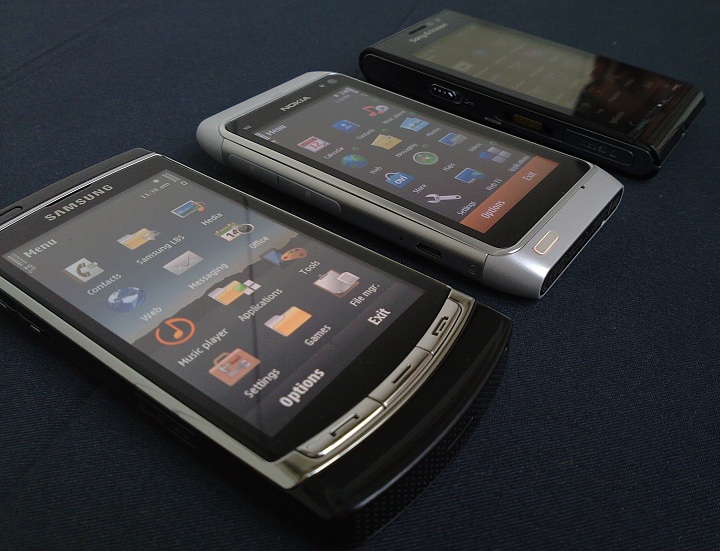xt-align: center;">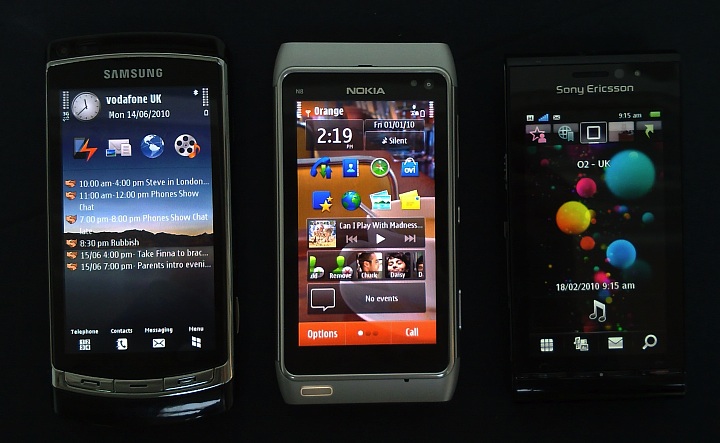
Symbian's three manufacturer flagships, ready to take on the world? Left to right: Samsung i8910 HD, Nokia N8, Sony Ericsson Satio
The industry does seem to be standardising, at the top end, on one-piece touchscreen tablets and this theme is represented here - despite my own belief that there are other interesting form factors - qwerty hybrids and clamshells, for example.
The inclusion of the Satio was debatable in that some might argue that the Vivaz is a better flagship, but the larger screen and higher end camera swung it for me. The i8910 HD is, of course, over a year old, but its specs were so far ahead of its time in 2009 that it now fits in well with the 2010 crop. Finally, the Desire was chosen as better-specified HTC Incredible isn't available in the UK or across much of the world.
(As usual, I've tinted the cells in each row that indicate an obvious 'winner' for that attribute, for interest sake. This was a system I believe I started and which has since been copied by others in the mobile world - ahem!)
| Apple iPhone 4 | Nokia N8 | Sony Ericsson Satio | Samsung i8910 HD | HTC Desire | |
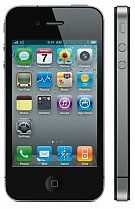 |
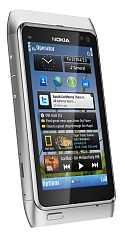 |
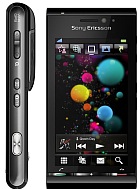 |
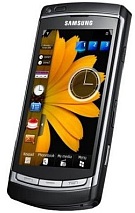 |
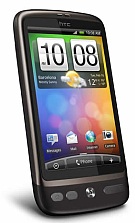 |
|
| OS and latest firmware | iOS 4 | Symbian^3, firmware version not known | Symbian OS 9.4, S60 5th Edition, R2AK006 firmware | Symbian OS 9.4, S60 5th Edition, HX4 (based on official firmware, but with five times the free system disk space) - up to date, but not official | Android OS 2.1 |
| Form factor, materials | Tablet, Stainless steel, tempered glass capacitive touchscreen, 137g | Tablet, Aluminium, plastics, tempered glass capacitive touchscreen, 135g | Tablet, Plastics, metal camera cover, resistive touchscreen, 126g | Tablet, Plastic, but very solid capacitive touchscreen, 148g | Tablet, metal and plastics, tempered glass capacitive touchscreen, 135g |
| Input mechanisms | On-screen virtual, multi-touch qwerty keyboard, writing aids | On-screen virtual, single-touch qwerty keyboard, plus virtual numeric and handwriting options (depending on market), writing aids | On-screen virtual, multi-touch qwerty keyboard | On-screen Virtual, single-touch qwerty keyboard (with no writing aids), plus virtual numeric and handwriting options, all with super haptic and aural feedback | On-screen virtual, multi-touch qwerty keyboard, writing aids |
| Display | 3.5" (640 x 960 pixels) IPS TFT, great colour accuracy indoors, fades and hard to read in direct sunlight | 3.5" (360 x 640 pixels) second generation AMOLED, gorgeous indoors, but hard to read in direct sunlight | 3.5" (360 x 640 pixels) transflective TFT, good enough indoors, still hard to read in sunlight because of resistive touch layer | 3.7" (360 x 640 pixels) AMOLED, gorgeous indoors, but almost impossible to read in direct sunlight | 3.7" (480 x 800 pixels) AMOLED, gorgeous indoors, but almost impossible to read in direct sunlight |
| Interface | iPhone OS with full kinetic scrolling and direct UI | Symbian^3, full kinetic scrolling, one-touch paradigm | S60 5th Edition, kinetic scrolling only in Sony Ericsson media suite layers | S60 5th Edition, full kinetic scrolling throughout | Android + Sense UI, kinetic scrolling and direct UI |
| Speed, multitasking, processor | Expected to be quick, aside from app relaunching due to partial multitasking, plenty of RAM, custom A4 processor | Quick, full multitasking, plenty of RAM, ARM 11 processor at 680MHz, plus graphics coprocessor | Quickish, full multitasking, plenty of RAM, ARM Cortex-A8 600MHz processor plus graphics coprocessor | Quickish, full multitasking, plenty of RAM, ARM Cortex-A8 600MHz processor plus graphics coprocessor. Some OS operations slower than they should be (e.g. opening the Applications folder) | Quick, full multitasking, adequate RAM, very fast 1GHz Snapdragon processor |
| Memory capacity (storage) | 16GB or 32GB integral storage. No expansion. | 135MB of (C:) system disk, plus 16GB mass memory and microSD expansion by another 32GB. Apps can be installed on any disk. USB-on-the-go lets users mount USB memory sticks and even hard disks - in theory. | 79MB of (C:) system disk, plus microSD expansion by another 32GB. Apps can be installed on any disk. | 85MB of (C:) system disk, plus 8GB (or 16GB) mass memory and microSD expansion by another 32GB. Apps can be installed on any disk. | Up to 512MB of internal flash memory, plus microSD expansion by another 32GB. Apps installed on internal only (at present) |
| Camera (stills) | Good 5 megapixel sensor, LED flash, exposed camera glass | Superb 12 megapixel sensor (largest ever put into a phone by far), X enon flash, exposed camera glass | Good 12 megapixel sensor, Xenon flash | 8 megapixel stills, but only LED flash. Exposed (but recessed) camera glass | Average 5 megapixel sensor, LED flash, exposed camera glass |
| Camera (video) | Adjustable focus 720p recording, with on-board editing, great audio | High depth of field 720p recording, with on-board editing, great audio | WVGA recording, poor audio capture | Initial focus 720p recording, though audio is either noisy or slightly choppy (depending on configuration) | Initial focus WVGA recording at jerky 15fps, poor audio capture |
| GPS and navigation | GPS and digital compass. Third party software needed for real time navigation | GPS and digital compass. Ovi Maps Navigation built-in | GPS only. Wisepilot trial version, have to pay afterwards | GPS and digital compass. Poor support of the initially-offered Route 66 software. Most users resort to Google Maps. Or to modified (ahem) Ovi Maps 3.3. | GPS and digital compass. Google Maps Navigation now in many Euro countries. |
| Audio out | Loud mono speaker, 3.5mm jack | Loud mono speaker, 3.5mm jack, plus HDMI audio out to compatible equipment | Average mono speaker, proprietary audio out cable | Very loud stereo speakers, 5.1 channel simulation(!), 3.5mm jack | Average mono speaker, 3.5mm jack |
| Web browsing | Responsive browser with kinetics and reflow, no Flash | Adequate browser with kinetics and Flash support | Adequate browser and Flash support | Adequate browser and Flash support | Responsive browser with kinetics and reflow, plus Flash support |
| Youtube and video playback | Dedicated YouTube client, plus movies loaded via iTunes | YouTube client a free download, uses low resolution streams currently. General video playback of MP4 good, HDMI output of video to HD equipment with surround sound. | YouTube client built-in, uses low resolution streams currently. General video playback of MP4 good | YouTube client a free download, uses low resolution streams currently. General video playback good, including DivX and XviD | Dedicated YouTube client with HQ stream support, plus average MP4 playback |
| Application store and ecosystem | iPhone App Store now legendary - tremendous selection | Ovi Store reasonably stocked, though weak in some areas (e.g. quality games) | PlayNow app store small by modern standards | No on-device store, but many S60 5th Edition apps will work fine. Some trial and error needed. See also our freeware guide | Android Market reasonably stocked, lots of free apps, though weak in some areas (e.g. quality games) |
| Battery | Estimated at 1600mAh (Apple won't say), not user changeable | 1200mAh, not user changeable | 1000mAh, via proprietary charger, user swappable battery | 1500mAh, microUSB charging, user swappable battery | 1400mAh, microUSB charging, user swappable battery |
| Ongoing firmware support and updates | Regular updates by Apple are expected, applied through iTunes on a Mac or PC. | True over the air and Ovi Suite updates should be fairly regular. | Via Sony Ericsson Update Service utility only. Official updates are infrequent and development seems to have stopped. | Via PC Studio only. Samsung updates have been profligate with C: disk space, so I recommend sticking with the modified HX versions, also applied via a PC utility through Samsung's built-in bootloader. | Some (minor) over the air updates, plus PC-driven major updates. Android 2.2 expected shortly. |
| Price (SIM-free, including local taxes in the UK, as at June 2010) | From £499 | £399 expected | Around £380 | Around £350 | Around £399 |
Looking at the blue 'wins' gives:
- 7 pts - Nokia N8
- 4 pts - Apple iPhone 4
- 3 pts - HTC Desire
- 2 pts - Samsung i8910 HD
- 0 pts - Sony Ericsson Satio
Interestingly, the N8's dominance when pitched head to head against all the competition was also borne out by Engadget's roundup from a week or so ago, faced with similarly-specified competition. Of course, despite my attempt to put real world observations and subjectivity into the table cell comments above, there is, ultimately, more to a successful smartphone than beating off newcomers with raw functions and specifications. The iPhone has been successful in the past at producing a holistic device, something which seems complete and satisfying within its own boundaries - those of Nokia's N8 are only a little wider and it would be nice to think that Symbian^3 will produce as many warm thoughts in the minds of buyers.
Will we see Symbian^3 designs from Sony Ericsson and Samsung? I'm pretty sure the answer there is 'Yes', though each does of course have more than one mobile OS on the go, so they won't be able to put the resources into products that, say, Nokia can afford to, with its heavy Symbian focus.
Of more significance than the differences above are the similarities - from form factor to functions, there's a lot of common ground in this market and a real danger that all devices will end up looking alike and doing much the same job. Again, the ex-Psioneer in me yearns for more interesting form factors, bringing in non-compromised physical qwerty keyboards.
Until then, though, the N8 is the Symbian^3 flag-bearer. Although noone in the world has yet played with production software, Rafe and I were quite impressed by how complete the device is currently. And judging from the table above, despite its lower price, the N8 should still manage to take the fight to the iPhone 4s and Desires of this world....
Steve Litchfield, All About Symbian, 16 June 2010
